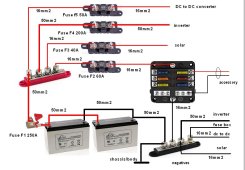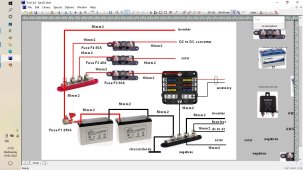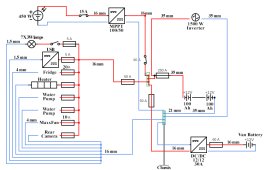mikefitz
Solar Wizard
- Joined
- May 28, 2020
- Messages
- 2,971
Comments on your diagram.
Fuse in solar panel feed not required. An isolation switch in place of the fuse would be useful.
All fuses as near as practical to the power source , the batteries, not as shown.
You need positive and negative buss bars near the battery.
with a 450 watt panel a Victron 100/30 will be OK.
You need more system fuses, a 50A between the battery and the cable to the DC to DC converter.
With the DC to DC both the positive and negative cables need to be 16mm2.
the inverter cables 35mm2 if short run , if over 2 meter 50mm2.
you need a fuse, 60A is typical, at the battery to feed the fuse box cable.
The fuses protect the cable so the connection between the positive buss bar and fuse holders should be as short as possible. A master fuse at the battery is a good idea. a bluesea MRBF could be used.
The van metal work needs to be connected to the negative and also the inverter casing.

A permanent install of an inverter needs protective devices to comply with regulations in many countries if its feeding multiple circuits and appliances. Consult the inverter supplier/instructions for advice how to implement this. The risk of electric shock exists without protective circuits.
Had a think. You could reduce the fuse count by feeding the inverter from F1.

Mike
Fuse in solar panel feed not required. An isolation switch in place of the fuse would be useful.
All fuses as near as practical to the power source , the batteries, not as shown.
You need positive and negative buss bars near the battery.
with a 450 watt panel a Victron 100/30 will be OK.
You need more system fuses, a 50A between the battery and the cable to the DC to DC converter.
With the DC to DC both the positive and negative cables need to be 16mm2.
the inverter cables 35mm2 if short run , if over 2 meter 50mm2.
you need a fuse, 60A is typical, at the battery to feed the fuse box cable.
The fuses protect the cable so the connection between the positive buss bar and fuse holders should be as short as possible. A master fuse at the battery is a good idea. a bluesea MRBF could be used.
The van metal work needs to be connected to the negative and also the inverter casing.

A permanent install of an inverter needs protective devices to comply with regulations in many countries if its feeding multiple circuits and appliances. Consult the inverter supplier/instructions for advice how to implement this. The risk of electric shock exists without protective circuits.
Had a think. You could reduce the fuse count by feeding the inverter from F1.

Mike
Last edited:




